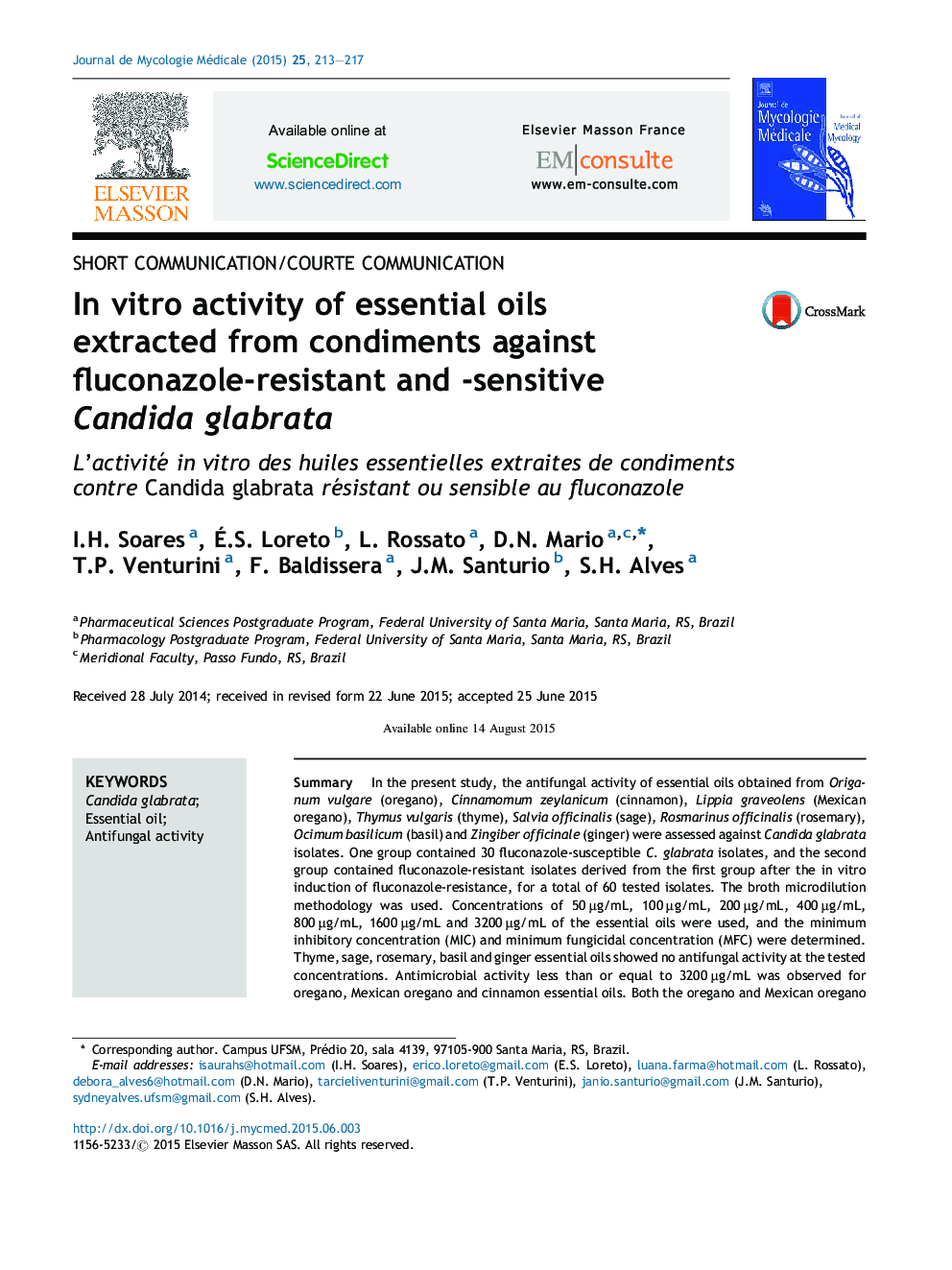| کد مقاله | کد نشریه | سال انتشار | مقاله انگلیسی | نسخه تمام متن |
|---|---|---|---|---|
| 3219219 | 1204444 | 2015 | 5 صفحه PDF | دانلود رایگان |

SummaryIn the present study, the antifungal activity of essential oils obtained from Origanum vulgare (oregano), Cinnamomum zeylanicum (cinnamon), Lippia graveolens (Mexican oregano), Thymus vulgaris (thyme), Salvia officinalis (sage), Rosmarinus officinalis (rosemary), Ocimum basilicum (basil) and Zingiber officinale (ginger) were assessed against Candida glabrata isolates. One group contained 30 fluconazole-susceptible C. glabrata isolates, and the second group contained fluconazole-resistant isolates derived from the first group after the in vitro induction of fluconazole-resistance, for a total of 60 tested isolates. The broth microdilution methodology was used. Concentrations of 50 μg/mL, 100 μg/mL, 200 μg/mL, 400 μg/mL, 800 μg/mL, 1600 μg/mL and 3200 μg/mL of the essential oils were used, and the minimum inhibitory concentration (MIC) and minimum fungicidal concentration (MFC) were determined. Thyme, sage, rosemary, basil and ginger essential oils showed no antifungal activity at the tested concentrations. Antimicrobial activity less than or equal to 3200 μg/mL was observed for oregano, Mexican oregano and cinnamon essential oils. Both the oregano and Mexican oregano essential oils showed high levels of antifungal activity against the fluconazole-susceptible C. glabrata group, whereas the cinnamon essential oil showed the best antifungal activity against the fluconazole-resistant C. glabrata isolates.
RésuméDans la présente étude, l’activité antifongique des huiles essentielles obtenues à partir d’Origanum vulgare (origan), Cinnamomum zeylanicum (cannelle), Lippia graveolens (origan du Mexique), Thymus vulgaris (thym), Salvia officinalis (sauge), Rosmarinus officinalis (romarin), Ocimum basilicum (basilic) et Zingiber officinale (gingembre) a été évaluée sur des isolats de Candida glabrata. Un groupe contenait 30 isolats sensibles au fluconazole et le second groupe contenait les isolats résistants au fluconazole dérivés du premier groupe après l’induction in vitro de la résistance au fluconazole, pour un total de 60 isolats testés. La méthode de microdilution a été utilisée. Les concentrations de 50 μg/mL, 100 μg/mL, 200 μg/mL, 400 μg/mL, 800 μg/mL, 1600 μg/mL et 3200 μg/mL d’huiles essentielles ont été utilisées, la concentration minimale inhibitrice (CMI) et la concentration minimale fongicide (CMF) ont été déterminées. Les huiles essentielles de thym, sauge, romarin, basilic et gingembre n’ont montré aucune activité antifongique aux concentrations testées. L’activité antimicrobienne inférieure ou égale à 3200 μg/mL a été observée pour l’huile essentielle de l’origan, l’origan mexicain et la cannelle. L’huile essentielle de l’origan et l’origan mexicain ont montré des niveaux élevés d’activité antifongique contre le groupe de C. glabrata sensible au fluconazole, tandis que l’huile essentielle de cannelle a montré la meilleure activité antifongique contre le groupe des isolats de C. glabrata résistants au fluconazole.
Journal: Journal de Mycologie Médicale / Journal of Medical Mycology - Volume 25, Issue 3, September 2015, Pages 213–217